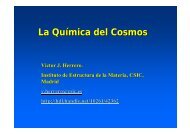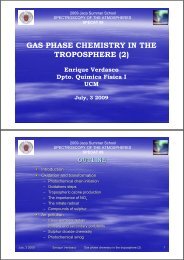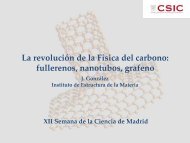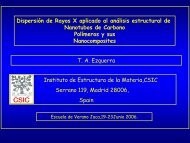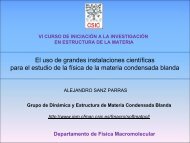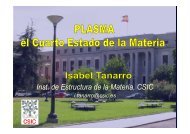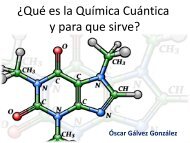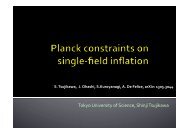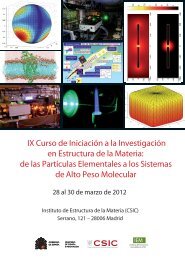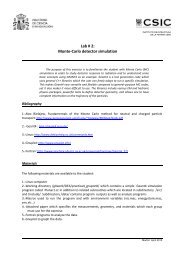The figure shows a compi<strong>la</strong>tion of the existing data on S34-factor along with our results (Madrid'11). 'Data pointsin colour' are taken from refs. [PRL 93(2004)262503](Weizmann'04), [PRL93 (2004)262503](LUNA06, 07), [Phys.Rev. C76 (2007)055801] (Seattle'07), [PRL 102(2009) 232502] (ERNA'09). The data points shown in grey comefrom Ref. [Rev. Mod. Phys. 83(<strong>2011</strong>)195]) and at medium energies is also inclu<strong>de</strong>d data from Parker et al. [Phys.Rev. 131(1963)2578], which do not agree with the Madrid'11 and ERNA'09. A normalized curve of the calcu<strong>la</strong>tionsma<strong>de</strong> by T. Neff, PRL 106(<strong>2011</strong>)042502 is over<strong>la</strong>id on the data points.The reaction 12 C(,) 16 O p<strong>la</strong>ys a key role in nuclear astrophysics as it <strong>de</strong>termines the carbon to oxygen ratio andstrongly influences the nucleosynthesis of all heavier elements. The cross section of this reaction at helium-burningtemperatures is of the or<strong>de</strong>r of 10 -17 barn, which ren<strong>de</strong>rs an experimental study unfeasible. The reaction is known tobe dominated by a sum of resonance tails and direct captures to both the ground and excited states of 16 O. Ofparticu<strong>la</strong>r interest are the 2 + and 1 - states located at 6917 and 7117 keV, respectively. Our group has proposed to usethe 19 F(p, ) 16 O reaction to popu<strong>la</strong>te the states of interest in 16 O. A first run test was performed at CMAM onDecember of <strong>2011</strong>. The experimental setup consisted of four dE-E telescopes, composed of two 60-m DSSDs +500-m PADs p<strong>la</strong>ced downstream of the target, plus two 20-m SSSDs + 300-m DSSDs. A primary beam ofprotons was accelerated at energies in the range 800 to 1500 keV, and impinged upon an MgF 2 target. The outgoingparticles were <strong>de</strong>tected in coinci<strong>de</strong>nce using the four <strong>de</strong>tectors. Our EXNUC Postdoc Ana D. Becerril will analyzethe data from this run in col<strong>la</strong>boration with L. Buchmann from TRIUMF, Canada. Monte Carlo simu<strong>la</strong>tions will beperformed and compared to experimental results. Based on our findings an optimized measurement will be proposedat CMAM <strong>la</strong>ter in 2012.DIPOLE POLARIZABILITY STUDY OF lIGHT NUCLEIOne of the most important and unexpected discoveries of Nuclear Physics in recent years has been the existence ofthe neutron halo in some nuclei near or at the drip line. A halo state is basically a threshold effect resulting from thepresence of bound states near the continuum. The combination of a small binding energy together with the shortrangeof nuclear forces allows the nucleon (or a cluster of nucleons) to go far away and to have a non-negligibleprobability at distances much greater than the normal nuclear radius (= r o A 1/3 , r o = 1.2 fm).The po<strong>la</strong>rizability parameter is a fundamental property of a nucleus and it is a measure of its response to an externalelectric field. In the adiabatic limit (corresponding to high excitation energies), the <strong>de</strong>viation of the e<strong>la</strong>stic scatteringcross section with respect to the prediction of the Rutherford formu<strong>la</strong> is <strong>de</strong>termined by the strength of the dipolepo<strong>la</strong>rizability. Consequently, measuring the e<strong>la</strong>stic cross section of a nucleus by a heavy target at sub-Coulombenergies provi<strong>de</strong>s a practical method for <strong>de</strong>termining the po<strong>la</strong>rizability parameter of this nucleus.To <strong>de</strong>termine thepo<strong>la</strong>rizability in stable and standar nuclei and in the extreme case of halo nuclei we have performed experimentsboth at CMAM and in diffeent radioactive beam facilities. In the following we <strong>de</strong>scribe the advances done during<strong>2011</strong>.The effect of dipole po<strong>la</strong>rizability should be particu<strong>la</strong>rly <strong>la</strong>rge for nuclei with halo and should manifest as areduction of the e<strong>la</strong>stic cross section at <strong>la</strong>rge angles. So we have perfomed an experimental and theoretical study ofthe scattering of halo nuclei at energies near the Coulomb barrier. This project is carried out in col<strong>la</strong>boration withgroups from the Universities of Seville and Huelva, with whom we have associated units. We have studied twoneutron halo nuclei such as 6 He, see 2006 annual report, and in 2008 we measured 11 Li at TRIUMF (Canada) and wehave studied the one neutron halo in 11 Be at REX-ISOLDE (Eur.Phys J. A, 2009, PRL 2010 and PRC inpreparation). The analysis of the Triumf data is almost finished and forms the PhD thesis of our stu<strong>de</strong>nt (grantCSIC-Costa Rica) Mario Cubero. The result shows that the e<strong>la</strong>stic differential cross section obtained for 11 Li on lead56
show an enormous reduction that could only be exp<strong>la</strong>ined consi<strong>de</strong>ring dipolepo<strong>la</strong>rizability effects and coupling tothe continuum. These results have been presented at various conferences this year (FUSION11 Saint-Malo, France,Rutherfors Centenial Conference – Manchester UK), and they are now being summarized in an article.On November of <strong>2011</strong> our group performed an experiment at CMAM Madrid <strong>de</strong>dicated to measure the e<strong>la</strong>sticscattering cross section of 3 He on a heavy target. The aim of this work is to extract the dipole po<strong>la</strong>rizability of 3 He,and to compare it to previous measurements, which are in disagreement. A beam of 3 He was accelerated at the 5 MVTan<strong>de</strong>m at CMAM and impinged upon a 208 Pb target, covering the energy range between 9 and 15 MeV. The setupconsisted of two Double-si<strong>de</strong>d Silicon Strip Detectors (DSSD) p<strong>la</strong>ced at backward angles, plus one Si surface barrier<strong>de</strong>tector p<strong>la</strong>ced at 60º. Analysis of the data from this measurement is currently being carried out by our postdoc A.Becerril.BETA DECAY STUDY OF THE N=Z NUCLEUS 72 KrThe beta <strong>de</strong>cay of N=Z nucleus 72 Kr was measured at ISOLDE (CERN) with “Lucrecia”, a Total Absorption gammaSpectrometer (TAS) with the aim of <strong>de</strong>termining the sign of the <strong>de</strong>formation from the Gamow-Teller strengthdistribution. The analysis of the data showed up the need for further information on the competence betweenconversion electrons and gamma emission of low energy transitions. This is why we performed complementarymeasurements in or<strong>de</strong>r to <strong>de</strong>termine the conversion coefficients of low energy transitions in the daughter nucleus,72 Br. Of special interest was to <strong>de</strong>termine the half--life of the isomeric state at 101 keV in 72 Br and the multipo<strong>la</strong>rityof the gamma transition connecting with the ground state as the spin of the <strong>la</strong>tter has been <strong>de</strong>bated and it is still notfirmly established.The analysis of the electron conversion data has been performed and the results are in progress to be published. Theconversion coefficients of several low energy transitions in the beta <strong>de</strong>cay of 72 Kr have been <strong>de</strong>termined, allowing toextract valuable information on the spin-parity of several excited states in the daughter nucleus. In particu<strong>la</strong>r, themultipo<strong>la</strong>rity of the transition connecting the isomeric state with the ground state has been <strong>de</strong>termined as well as anew measurement of the half-life of the isomeric state through the study of the time evolution of the gammaemission of this <strong>de</strong>excitation.These results on the level scheme at low excitation energy of 72 Br allow us to face the analysis of the data taken withthe TAS “Lucrecia” which is currently in progress. The experimental distribution of Gamow-Teller strength in our<strong>de</strong>cay will be obtained from the beta feeding distribution to excited levels in 72 Br through the beta <strong>de</strong>cay of 72 Kr.This complete study of the beta <strong>de</strong>cay of N=Z nucleus 72 Kr is the main topic of the Ph. D. work of the stu<strong>de</strong>nt JoséA. Briz (PhD Fellowship-FPI).TRANSFER REACTIONS ON EXOTIC NEUTRON-RICH BEAMS AT REX-ISOLDESingle-nucleon transfer reactions constitute an excellent tool to study single-particle properties of nuclear states. Inparticu<strong>la</strong>r they provi<strong>de</strong> essential data to study the evolution of shell structure and of effective single-particle energiesaway from the line of beta stability. Dr. Riccardo Or<strong>la</strong>ndi, member of our group since June 2010 (and since January<strong>2011</strong> on a CPAN Postgraduate contract), is involved in the study of single-nucleon transfer reactions at REX-ISOLDE. The experiments exploit the coupling of the T-REX Si array to the MINIBALL germanium <strong>de</strong>tector array.In <strong>2011</strong> R. Or<strong>la</strong>ndi and A. Jungc<strong>la</strong>us were actively involved in the setup and running of one such experiment:72 Zn(t,p) 74 Zn, which took p<strong>la</strong>ce in October <strong>2011</strong>. R. Or<strong>la</strong>ndi is currently carrying on the data analysis for the78 Zn(d,p) 79 Zn experiment which was performed at ISOLDE at the end of 2010. Preliminary results from these datahave already been presented as oral contributions to three international conferences during <strong>2011</strong> (ARIS – Leuven,NCNP – Stockholm, Rutherford Centennial Conference – Manchester).EVIDENCE FOR A SPIN-ALIGNED NEUTRON-PROTON PAIRED PHASE FROM THE LEVELSTRUCTURE OF 92 PdIn an experiment performed at GANIL (Caen, France), the excitation scheme of the extremely neutron <strong>de</strong>ficientnucleus 92 Pd has been studied for the first time within an international col<strong>la</strong>boration. The Pd nuclei were producedusing a fusion-evaporation reaction and i<strong>de</strong>ntified using the gamma spectrometer EXOGAM, the CsI arrayDIAMANT for charge particle <strong>de</strong>tection and a neutron wall comprising 50 liquid scintil<strong>la</strong>tors. The study was aimedat investigating a long standing question that has received consi<strong>de</strong>rable attention in nuclear physics – whether a newtype of pair corre<strong>la</strong>tions between neutrons and protons (“isosca<strong>la</strong>r pairing” where the proton and neutron spins arefully aligned) could appear in nuclei with equal numbers of neutrons and protons. In all atomic nuclei studied untilnow, the low-lying structures are generally characterized by pair corre<strong>la</strong>tions between like-nucleon pairs, i.e. pairs ofneutrons and pairs of protons. Since these are i<strong>de</strong>ntical particles they must, according to the Pauli Principle, have57
- Page 3:
INTRODUCCIÓNEl Instituto de Estruc
- Page 10 and 11: Dra. Maria Esperanza Cagiao Escohot
- Page 12 and 13: TALLER ÓPTICOD. José Lasvignes Pa
- Page 14 and 15: 2A.1 DPTO. DEQUÍMICA YFÍSICA TEÓ
- Page 16: empezar a caer. Este fenómeno se e
- Page 19 and 20: Existen varias diferencias entre la
- Page 21 and 22: Estudio de las propiedades estructu
- Page 23 and 24: poblar los estados de interés en 1
- Page 25 and 26: Si bien la técnica TF está bien e
- Page 27 and 28: que no se produzca la ruptura de en
- Page 30 and 31: antitumoral emodina mediante el efe
- Page 32 and 33: Esta formulación ha sido desarroll
- Page 34 and 35: oooooCriogenia.Espectroscopía Rama
- Page 36 and 37: FLUIDODINÁMICA MOLECULAREl princip
- Page 38 and 39: También se ha concluido y publicad
- Page 40 and 41: o Análisis mecánico en tracción:
- Page 42 and 43: cuerpo (BCC), tiene lugar la formac
- Page 44 and 45: BIOSAXSCaracterización de coloides
- Page 46 and 47: Sin embargo, desde el punto de vist
- Page 48 and 49: 2B.1 THEORETICAL PHYSICS AND CHEMIS
- Page 50 and 51: terms and that b) stellar pulsation
- Page 52 and 53: We have investigated transport thro
- Page 54 and 55: een proposed as possible interstell
- Page 58 and 59: oppositely aligned spins. This pair
- Page 60 and 61: PHYSICAL BEHAVIOR AT NANO-SCALESPro
- Page 62 and 63: done in collaboration with research
- Page 64 and 65: Finally, we have also conducted a w
- Page 66 and 67: species have been obtained from tim
- Page 68 and 69: Rideal mechanism, with a preference
- Page 70 and 71: Liquid hydrogen filament (5 micron
- Page 72 and 73: Nanostructure of polymer thin films
- Page 74 and 75: morphological model for Natural Rub
- Page 76 and 77: product. The clay can be used direc
- Page 78 and 79: with the extracellular ERBBs domain
- Page 80 and 81: 3.1 DPTO. DEQUÍMICA YFÍSICA TEÓR
- Page 82 and 83: Duration: January 2010-December 201
- Page 84 and 85: Objectives: This Project aims at ob
- Page 86 and 87: Funding Institution: Comunidad de M
- Page 89 and 90: CAPÍTULO 4COOPERACIÓN CIENTÍFICA
- Page 91 and 92: 4.1.3 DPTO. DE FÍSICA MOLECULAR /
- Page 93 and 94: o Complete Hybrid Quantization of a
- Page 95 and 96: R3B Collaboration Meeting, Darmstad
- Page 97 and 98: SERS Roundtable 2011, Poltersdorf (
- Page 99 and 100: International Conference on Process
- Page 101 and 102: 4.3. ESTANCIAS DE INVESTIGADORES EN
- Page 103 and 104: Dr. Francesca Vidotto.Université d
- Page 105 and 106: 4.4.3 DPTO. DE FÍSICA MOLECULAR /
- Page 107:
Guillermo Ribeiro Jiménez. Subatom
- Page 110 and 111:
5.1 DOCENCIA / TEACHING5.1.1 DPTO.
- Page 112 and 113:
5.1.3 DPTO. DE FÍSICA MOLECULAR /
- Page 114 and 115:
5.2.3 DPTO. DE FÍSICA MOLECULAR /
- Page 116 and 117:
Óscar Gálvezo Hielos y Plasmas de
- Page 118 and 119:
Olof Tengblad- Deputy Technical Man
- Page 120 and 121:
5.5 ACTIVIDADES Y MATERIAL DE DIVUL
- Page 122 and 123:
Plasma, el cuarto estado de la mate
- Page 124 and 125:
5.7 UNIDADES ASOCIADAS Y OTRAS ACTI
- Page 126 and 127:
oScientific collaboration on “Din
- Page 128 and 129:
6.1 PUBLICACIONES EN REVISTAS Y PRO
- Page 130 and 131:
Prescriptions in Loop Quantum Cosmo
- Page 132 and 133:
Richardson-Gaudin Models: The Hyper
- Page 134 and 135:
79. L. Guerrini, S. Sanchez-Cortes,
- Page 136 and 137:
Probing the Nature of Particle-Core
- Page 138 and 139:
PROCEEDINGS ISI /ISI PROCEEDINGS120
- Page 140 and 141:
Physical Review Letters 106, 245301
- Page 142 and 143:
Conducting Nanocomposites Based on
- Page 144 and 145:
3. O. S. Kirsebom, S. Hyldegaard, M
- Page 146 and 147:
6.4 TESIS DOCTORALES / Ph. D. THESE
- Page 149 and 150:
CAPÍTULO 7TABLAS Y DATOSCHAPTER 7T
- Page 151 and 152:
Spectrochimica Acta B 2 3.552Chemph
- Page 153 and 154:
7.4 PERSONAL POR DEPARTAMENTOS /PER
- Page 155 and 156:
ÍNDICEINDEX155
- Page 157 and 158:
4.1.2 Dpto. de Espectroscopía Nucl
- Page 159:
6.2.2 Dpto. de Espectroscopía Nucl




